Use of Geoinformatics for the Digitization and Visualization of Sensitive Space in the Urban Landscape: A Case Study of the Gross-Rosen Sub-Camps Systems
Abstract
1. Introduction
2. Study Area: Historical Setting
2.1. Labour Camp Dyhernfurth I
2.2. Labour Camp Dyhernfurth II
3. Materials and Methods
3.1. Aerial Photographs from the United States National Archives and Record Administration (NARA)
3.2. Aerial Photographs, Orthophotomaps, Laser Scanning Data, and Spatial Databases from the Head Office of Geodesy and Cartography in Poland
- shaded relief maps;
- visualizations based on principle component analysis (PCA);
- sky view factor;
- topographical openness;
3.3. Data Interpretation Process and Visualisations
4. Results
4.1. Sub-Camp Dyhernfurth 1 (AL Dyhernfurth I)
4.2. Sub-Camp Dyhernfurth 2 (AL Dyhernfurth II)
4.3. Implementing the Geoportal and Walk around the Surveyed Area of of the Camp Remains
4.4. Laser Scanning Data and Products Analysis
5. Discussion
6. Conclusions
Supplementary Materials
Author Contributions
Funding
Data Availability Statement
Acknowledgments
Conflicts of Interest
Correction Statement
References
- Abramov, A.E.; Veselovskaya, A.; Dolgov, A.V.; Engovatova, M.B.; Mednikova, S.; Nikitin, S.; Safarov, A. Forensic Archaeology in the Russian Federation. In Forensic Archaeology: Global Perspectives; Groen, M., Márquez-Grant, M., Janaway, M., Eds.; Wiley-Blackwel: Chichester, UK, 2015; pp. 139–148. [Google Scholar]
- Djurić, M.; Pavlović, T. Excavation of Mass Graves with Serbian Context: Complexity of the Political Milieu. Forensic Sci. Int. 2021, 319, 110657. [Google Scholar] [CrossRef]
- Kobiałka, D.; Kostyrko, M.; Wałdoch, F.; Kość-Ryżko, K.; Rennwanz, J.; Rychtarska, M.; Nita, D. An archaeology of Death Valley, Poland. Antiquity 2021, 95, e29. [Google Scholar] [CrossRef]
- Bem, M. Sobibór Niemiecki Ośrodek Zagłady 1942–1943; Muzeum Hitlerowskiego Obozu Zagłady w Sobiborze: Sobibór, Poland, 2012. [Google Scholar]
- Gilead, I.; Haimi, Y.; Mazurek, W. Excavating Nazi extermination centres. Present Pasts 2010, 1, 12. [Google Scholar] [CrossRef]
- Masciotta, M.; Sánchez-Aparicio, L.; Bishara, S.; Oliveira, D.; González-Aguilera, D.; García-Alvarez, J. Digitization of cultural heritage buildings for preventive conservation purposes. In Proceedings of the 12th International Conference on Structural Analysis of Historical Constructions (SAHC), Barcelona, Spain, 16–18 September 2020. [Google Scholar]
- Doğan, Y.; Yakar, M. GIS and three-dimensional modeling for cultural heritages. Int. J. Geosci. 2018, 3, 50–55. [Google Scholar] [CrossRef]
- Santos, B.; Gonçalves, J.; Almeida, P.G. GIS-based inventory for safeguarding and promoting Portuguese glazed tiles cultural heritage. Herit. Sci. 2003, 11, 133. [Google Scholar] [CrossRef]
- Emanuele, P.; Maietti, F.; Di Giulio, R.; Schippers-Trifan, O.; Van Delft, A.; Bruinenberg, S.; Olivadese, R. BIM-based Cultural Heritage Asset Management Tool. Innovative Solution to Orient the Preservation and Valorization of Historic Buildings. Int. J. Archit. 2001, 15, 897–920. [Google Scholar]
- Sánchez-Aparicio, L.J.; Masciotta, M.G.; García-Alvarez, J.; Ramos, L.F.; Oliveira, D.V.; Martín-Jiménez, J.A.; Monteiro, P. Web-GIS approach to preventive conservation of heritage buildings. Autom. Constr. 2020, 118, 103304. [Google Scholar] [CrossRef]
- Drozdzewski, D. When the Everyday and the Sacred Collide: Positioning Płaszów in the Kraków Landscape. Landsc. Res. 2014, 39, 251–258. [Google Scholar] [CrossRef]
- Wertejuk, Z.; Koch, M.; Marciniak, W. Recovered Old Arsenical and ‘Mustard’ Munitions in Poland: Technologies, Plans and Problems. In Arsenic and Old Mustard: Chemical Problems in the Destruction of Old Arsenical and ‘Mustard’ Munitions; Bunnett, J., Mikołajczyk, M., Eds.; Springer: Dordrecht, The Netherlands, 1998; pp. 91–104. [Google Scholar]
- Friedrich, B.; Hoffmann, D.; Renn, J.; Schmaltz, F.; Wolf, M. One Hundred Years of Chemical Warfare: Research, Deployment, Consequences; Springer International Publishing: Cham, Switzerland, 1997. [Google Scholar]
- Ballantyne, B.; Marrs, T.C. Clinical and Experimental Toxicology of Organophosphates and Carbamates; Elsevier: London, UK, 1992. [Google Scholar]
- Bajgar, J.; Fusek, J.; Kassa, J.; Kuca, K.; Jun, D. Global impact of chemical warfare agents used before and after 1945. In Handbook of Toxicology of Chemical Warfare Agents; Gupta, R., Ed.; Elsevier: London, UK, 1992; pp. 27–36. [Google Scholar]
- Sprenger, I. Gross-Rosen. In Ein Konzentrationslager in Schlesien; Böhlau Verlag: Cologne, Germany, 1996. [Google Scholar]
- Czernik, H. Filie obozu koncentracyjnego w Brzegu Dolnym. In Studia nad Faszyzmem i Zbrodniami Hitlerowskimi; Jońc, K., Ed.; Państwowe Wydawnictwo Naukowe; Oddział Wrocławski: Wrocław, PL, USA, 1974. [Google Scholar]
- Olszyna, R. Żydzi w KL Dyhernfurth. KL Gross-Rosen—Wybór Artykułów; Muzuem Gross Rosen: Wałbrzych, PL, USA, 2005. [Google Scholar]
- Hałgas, K. Byłem w KL Gross-Rosen i Dyhernfurth. Wspomnienia Lekarza-Więźnia; Muzuem Gross Rosen: Wałbrzych, PL, USA, 2013. [Google Scholar]
- Konarzewski, N. Powrót Niepożądany. Wspomnienia Romana Konarzewskiego; Self Publishing: Warszawa, PL, USA, 2021. [Google Scholar]
- Sula, D. Żydzi Polscy w Konzentrationslager Gross-Rosen; Muzuem Gross Rosen: Wałbrzych, PL, USA, 2020. [Google Scholar]
- Kobielec, A. Dyhernfurth I, Dyhernfurth II (Brzeg Dolny). In Der Ort des Terrors. Geschichte der Nationalsozialistischen Konzentrationslager; C. H. Beck: München, DE, USA, 2007; pp. 278–286. [Google Scholar]
- Schmidt, U. Accidents and experiments: Nazi chemical warfare research and medical ethics during the Second World War. In Military Medical Ethics for the 21st Century; Gross, M., Carrick, D., Eds.; Routledge: London, UK, 2013; pp. 225–244. [Google Scholar]
- Koelle, G. Organophosphate Poisoning—An Overview. Toxicol. Sci. 1981, 1, 129–134. [Google Scholar] [CrossRef]
- Redecker, A.P. Historical aerial photographs and digital photogrammetry for impact analyses on derelict land sites in human settlement areas. Int. Arch. Photogramm. Remote Sens. Spat. Inf. Sci. 2008, 37, 5–10. [Google Scholar]
- Różycki, S.; Karwel, A.K.; Kurczyński, Z. German Extermination Camps on WWII Reconnaissance Photographs. Orthorectification Process for Archival Aerial Images of Cultural Heritage Sites. Remote Sens. 2023, 15, 2587. [Google Scholar] [CrossRef]
- Bożek, P.; Janus, J.; Mitka, B. Analysis of Changes in Forest Structure using Point Clouds from Historical Aerial Photographs. Remote Sens. 2019, 11, 2259. [Google Scholar] [CrossRef]
- Kamola, A.; Różycki, S.; Bylina, P.; Lewandowski, P.; Burakowski, A. Forgotten Nazi Forced Labour Camps: Arbeitslager Riese (Lower Silesia, SE Poland) and the Use of Archival Aerial Photography and Contemporary LiDAR and Ground Truth Data to Identify and Delineate Camp Areas. Remote Sens. 2020, 12, 1802. [Google Scholar] [CrossRef]
- Dyba, K.; Nowosad, J. rgugik: Search and Retrieve Spatial Data from the Polish Head Office of Geodesy and Cartography in R. J. Open Source Softw. 2021, 6, 29–48. [Google Scholar] [CrossRef]
- Doskocz, A. The actual state of the geodetic and cartographic resources and legislation in Poland. Open Geosci. 2022, 15, 20220458. [Google Scholar] [CrossRef]
- Neumann, K. Operational aspects of digital aerial mapping cameras. The International Archives of the Photogrammetry. Int. Arch. Photogramm. Remote Sens. 2004, 35, 222–225. [Google Scholar]
- Felipe-García, B.; Hernández-López, D.; Lerma, J.L. Analysis of the ground sample distance on large photogrammetric surveys. Appl. Geomat. 2012, 4, 231–244. [Google Scholar] [CrossRef]
- Paixão, A.; Muralha, J.; Resende, R. Close-Range Photogrammetry for 3D Rock Joint Roughness Evaluation. Rock. Mech. Rock. Eng. 2022, 55, 3213–3233. [Google Scholar] [CrossRef]
- Chen, C.; Guo, J.; Wu, H.; Li, Y.; Shi, B. Performance Comparison of Filtering Algorithms for High-Density Airborne LiDAR Point Clouds over Complex LandScapes. Remote Sens. 2021, 13, 2663. [Google Scholar] [CrossRef]
- Kurczyński, Z. Fotogrametria, 1st ed.; PWN S.A.: Warsaw, Poland, 2014. [Google Scholar]
- Kurczyński, Z.; Bakuła, K. Generowanie referencyjnego numerycznego modelu terenu o zasięgu krajowym w oparciu o lotnicze skanowanie laserowe w projekcie ISOK. In Monografia “Geodezyjne Technologie Pomiarowe”: Wydanie Specjalne; Kurczyński, Z., Ed.; Zarząd Główny Stowarzyszenia Geodetów Polskich: Warsaw, Poland, 2013; pp. 59–68. [Google Scholar]
- Kurczyński, Z. Airborne Laser Scanning in Poland—Between Science and Practice. Archives of Photogrammetry. Cartogr. Remote Sens. 2019, 31, 105–133. [Google Scholar]
- Bakuła, K.; Ostrowski, W.; Zapłata, R.; Kurczyński, Z.; Kraszewski, B.; Stereńczak, K. Zalecenia w Zakresie Pozyskiwania, Przetwarzania, Analizy i Zastosowania Danych LIDAR w Celu Rozpoznania Zasobów Dziedzictwa Archeologicznego w Ramach Programu AZP; Politechnika Warszawska: Warszawa, Poland, 2016. [Google Scholar]
- Banaszek, Ł. Lotniczy skaning laserowy w polskiej archeologii. Czy w pełni wykorzystywany jest potencjał prospekcyjny metody? Folia Praehist. Posnan. 2014, 19, 207–251. [Google Scholar] [CrossRef]
- Kokalj, Ž.; Hesse, R. Airborne Laser Scanning Raster Data Visualization: A Guide to Good Practice; Založba ZRC: Ljubljana, Slovakia, 2017; Volume 14. [Google Scholar]
- Kokalj, Ž.; Zakšek, K.; Oštir, K.; Pehani, P.; Čotar, K.; Somrak, M.; Kokalj, Ž. Relief Visualization Toolbox, ver. 2.2. 1 Manual. Remote Sens. 2016, 3, 398–415. [Google Scholar]
- Štular, B.; Kokalj, Ž.; Oštir, K.; Nuninger, L. Visualization of lidar-derived relief models for detection of archaeological features. J. Archaeol. Sci. 2012, 39, 3354–3360. [Google Scholar] [CrossRef]
- Doneus, M. Openness as Visualization Technique for Interpretative Mapping of Airborne LiDAR Derived Digital Terrain Models. Remote Sens. 2013, 5, 6427–6442. [Google Scholar] [CrossRef]
- Brașoveanu, C.; Mihu-Pintilie, A.; Brunchi, R.-A. Inside Late Bronze Age Settlements in NE Romania: GIS-Based Surface Characterization of Ashmound Structures Using Airborne Laser Scanning and Aerial Photography Techniques. Remote Sens. 2023, 15, 4124. [Google Scholar] [CrossRef]
- Ortiz-Villarejo, A.J.; Gutiérrez Soler, L.-M. A Low-Cost, Easy-Way Workflow for Multi-Scale Archaeological Features Detection Combining LiDAR and Aerial Orthophotography. Remote Sens. 2021, 13, 4270. [Google Scholar] [CrossRef]
- Kokalj, Z.; Zaksek, K.; Ostir, K. Application of sky-view factor for the visualisation of historic landscape features in lidar-derived relief models. Antiquity 2011, 85, 263–273. [Google Scholar] [CrossRef]
- Becker, D.; De Andrés-Herrero, M.; Willmes, C.; Weniger, G.-C.; Bareth, G. Investigating the Influence of Different DEMs on GIS-Based Cost Distance Modeling for Site Catchment Analysis of Prehistoric Sites in Andalusia. ISPRS Int. J. Geo-Inf. 2017, 6, 36. [Google Scholar] [CrossRef]
- Dz.U. 2011 nr 279 poz. 1642. Rozporządzenie Ministra Spraw Wewnętrznych i Administracji z dnia 17 listopada 2011 r. w Sprawie Bazy Danych Obiektów Topograficznych Oraz Bazy Danych Obiektów Ogólnogeograficznych, a Także Standardowych Opracowań Kartograficznych. Available online: https://isap.sejm.gov.pl/isap.nsf/DocDetails.xsp?id=WDU20112791642 (accessed on 14 February 2024).
- Nowak, M.M.; Dziób, K.; Ludwisiak, Ł.; Chmiel, J. Mobile GIS applications for environmental field surveys: A state of the art. Glob. Ecol. Conserv. 2020, 23, e01089. [Google Scholar] [CrossRef]
- De Miguel González, R.; De Lázaro Torres, M.L. WebGIS implementation and effectiveness in secondary education using the digital atlas for schools. J. Geog. 2020, 119, 74–85. [Google Scholar] [CrossRef]
- Phantuwongraj, S.; Chenrai, P.; Assawincharoenkij, T. Pilot Study Using ArcGIS Online to Enhance Students’ Learning Experience in Fieldwork. Geosciences 2021, 11, 357. [Google Scholar] [CrossRef]
- Tripcevich, N. Flexibility by design: How mobile GIS meets the needs of archaeological survey. Cartogr. Geogr. Inf. Sci. 2004, 31, 137–151. [Google Scholar] [CrossRef]
- Grabowski, R.; Olsen, B.; Pétursdóttir, Þ.; Witmore, C. Teillager 6 Sværholt: The archaeology of a World War II prisoner of war camp in Finnmark, arctic Norway. Fennosc. Archaeol. 2014, 31, 3–24. [Google Scholar]
- Seitsonen, O.; Herva, V.P. Forgotten in the wilderness: WWII German PoW camps in Finnish Lapland. In Archaeologies of Internment; Springer: New York, NY, USA, 2011; pp. 171–190. [Google Scholar]
- Van der Schriek, M.; Beex, W. The application of LiDAR-based DEMs on WWII conflict sites in the Netherlands. J. Confl. Archaeol. 2017, 12, 94–114. [Google Scholar] [CrossRef]
- Van der Schriek, J.; van der Schriek, M. Metal Detecting: Friend or Foe of Conflict Archaeology? Investigation, Preservation and Destruction on WWII sites in the Netherlands. J. Community Archaeol. Heritage. 2014, 1, 228–244. [Google Scholar] [CrossRef]
- Sensacyjne Ustalenia Naukowców Dotyczące Kompleksu Riese. Teraz Wielu Mieszkańców Może Mieć Spory Problem. Available online: https://walbrzych.wyborcza.pl/walbrzych/7,178336,30631727,chca-by-riese-stalo-sie-zabytkiem-trwa-kilkanascie-postepowan.html (accessed on 14 February 2024).
- Gillian, C. Examining the memorialscape of occupation and liberation: A case study from the Channel Islands. Int. J. Herit. Stud. 2012, 18, 174–193. [Google Scholar]
- Antkowiak, M.; Völker, E. Dokumentiert und konserviert. Ein Außenlager des Konzentrationslagers Sachsenhausen in Rathenow. Landkreis Havelland. Archäologie Berl. Brandenbg. 2000, 1999, 147–149. [Google Scholar]
- Carr, G.; Colls, C.S. Taboo and sensitive heritage: Labour camps, burials and the role of activism in the Channel Islands. Int. J. Herit. Stud. 2016, 22, 702–715. [Google Scholar] [CrossRef]
- Szacka, B.; Castle, M. Polish Remembrance of World War II. Int. J. of Sociol. 2006, 36, 8–26. [Google Scholar] [CrossRef]
- Kiarszys, G.; Banaszek, Ł. Dostrzec i zrozumieć. Porównanie wybranych metod wizualizacji danych ALS wykorzystywanych w archeologii. Folia Praehist. Posnan. 2017, 22, 233–270. [Google Scholar] [CrossRef]
- Kobiałka, D.; Kostyrko, M.; Lokś, A.; Karski, K.; Rezler-Wasielewska, V.; Stanek, P.; Wickiewicz, A.; Góra, E.; Tomczak, S.; Pawleta, M. “Hell camp” hidden in the forest—The materiality of Stalag VIII B (344) Lamsdorf. J. Confl. Archaeol. 2023, 18, 97–124. [Google Scholar] [CrossRef]
- Kostyrko, M.; Kobiałka, D. Small and large heritage of the Great War: An archaeology of a prisoner of war camp in Tuchola, Poland. Landsc. Res. 2020, 45, 583–600. [Google Scholar] [CrossRef]
- Colls, C.S.; Kerti, J.; Colls, K. Tormented Alderney: Archaeological Investigations of the Nazi Labour and Concentration Camp of Sylt. Antiquity 2020, 94, 512–532. [Google Scholar] [CrossRef]
- Juhász, A.; Mihályi, B. Object and event reconstruction (WW II) with GIS. Int. Arch. Photogramm. Remote Sens. Spat. Inf. Sci. 2006, 36, 145–149. [Google Scholar]
- Maio, C.V.; Tenenbaum, D.; Brown, C.; Mastone, V.T.; Gontz, M. Application of geographic information technologies to historical landscape reconstruction and military terrain analysis of an American Revolution Battlefield: Preservation potential of historic lands in urbanized settings, Boston, Massachusetts, USA. J. Cult. Herit. 2013, 14, 317–331. [Google Scholar] [CrossRef]
- Albuquerque, M.; Sanz, G.; Oliveira, S.; Martínez-Alegría, R.; Antunes, R. Spatio-temporal groundwater vulnerability assessment-a coupled remote sensing and GIS approach for historical land cover reconstruction. Water Resour. Manag. 2013, 27, 4509–4526. [Google Scholar] [CrossRef]
- Collado, A.; Mora-Navarro, G.; Heras, V.; Lerma, J.L. A Web-Based Geoinformation System for Heritage Management and Geovisualisation in Cantón Nabón (Ecuador). ISPRS Int. J. Geo-Inf. 2022, 11, 4. [Google Scholar] [CrossRef]

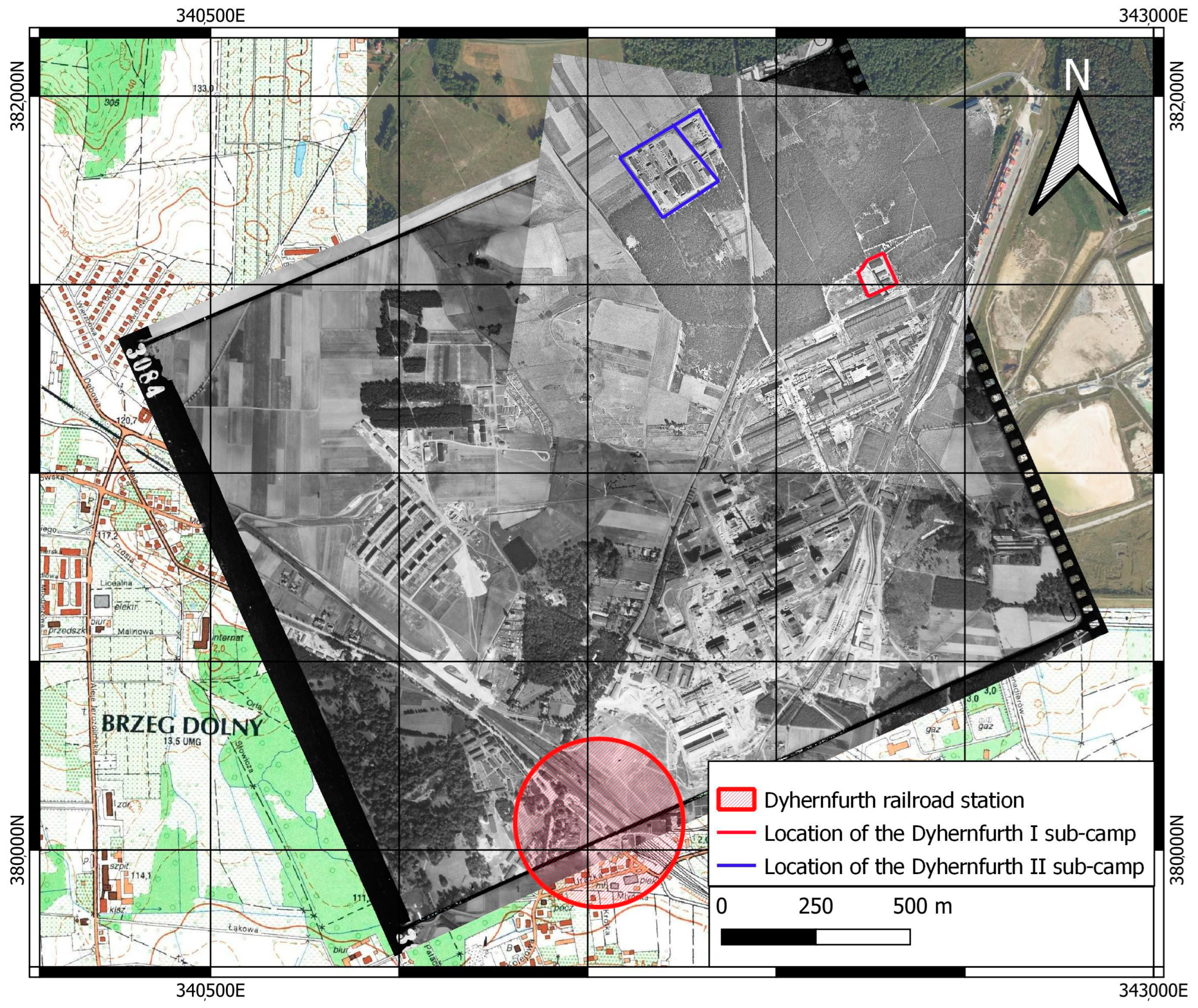
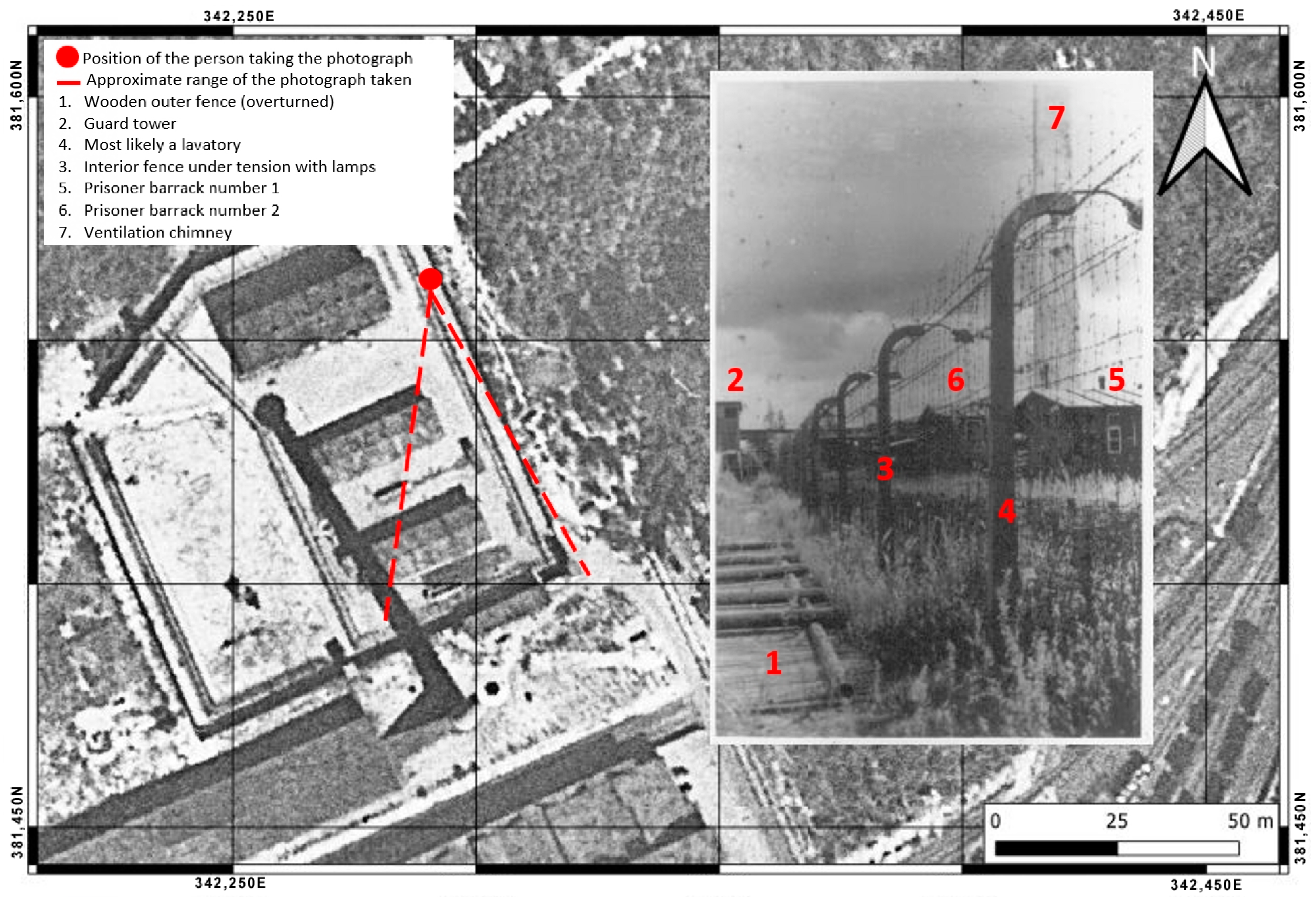
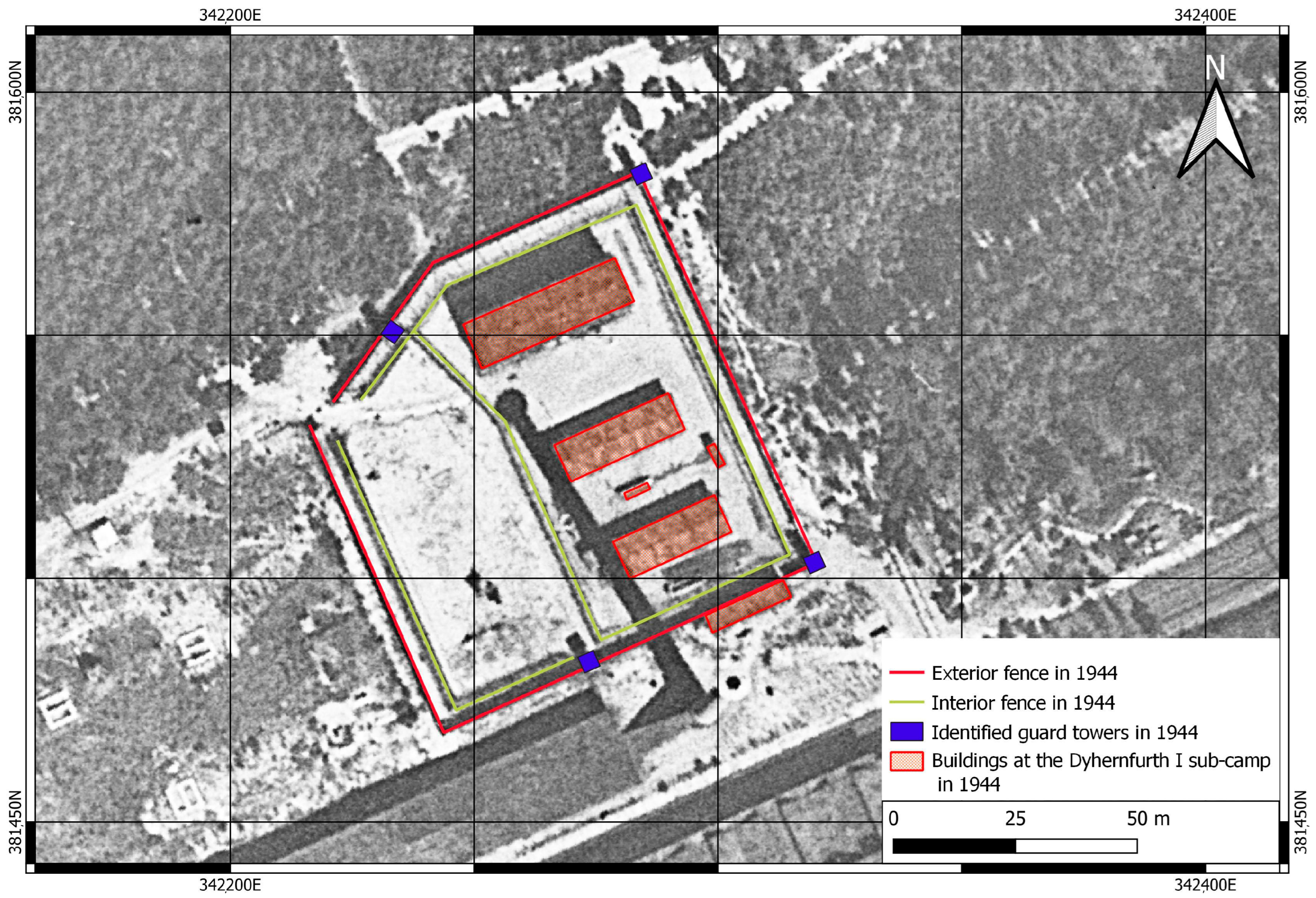
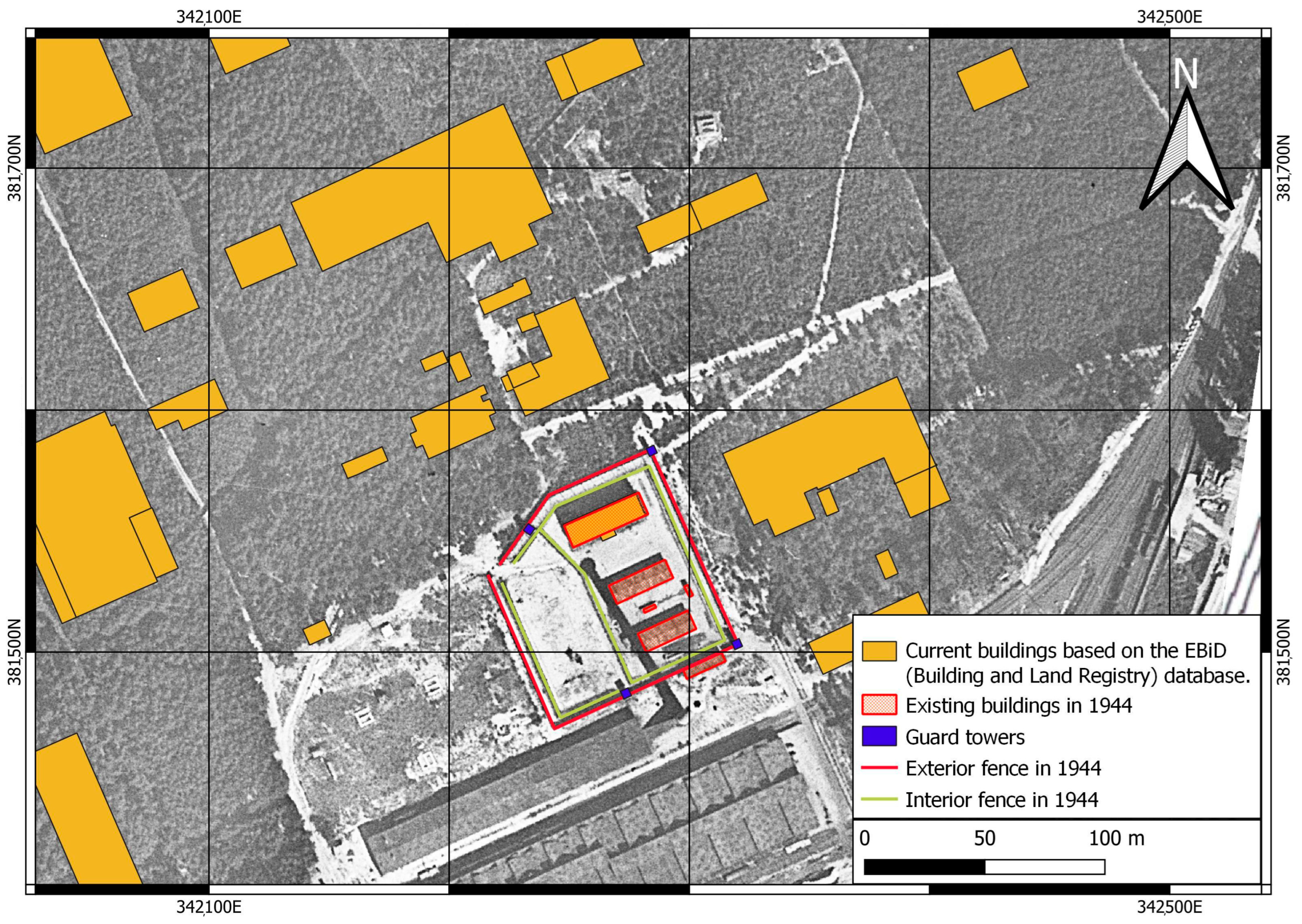
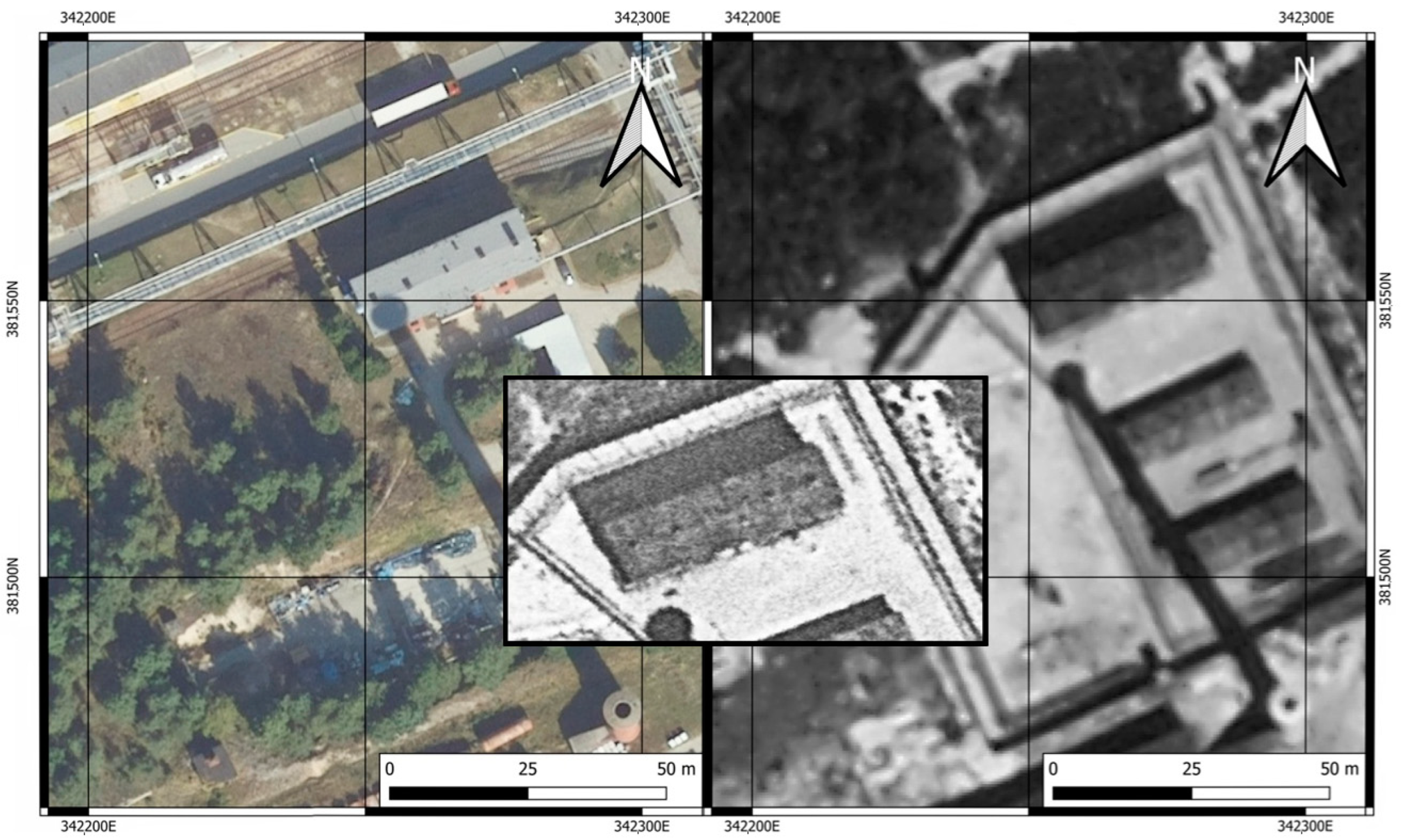

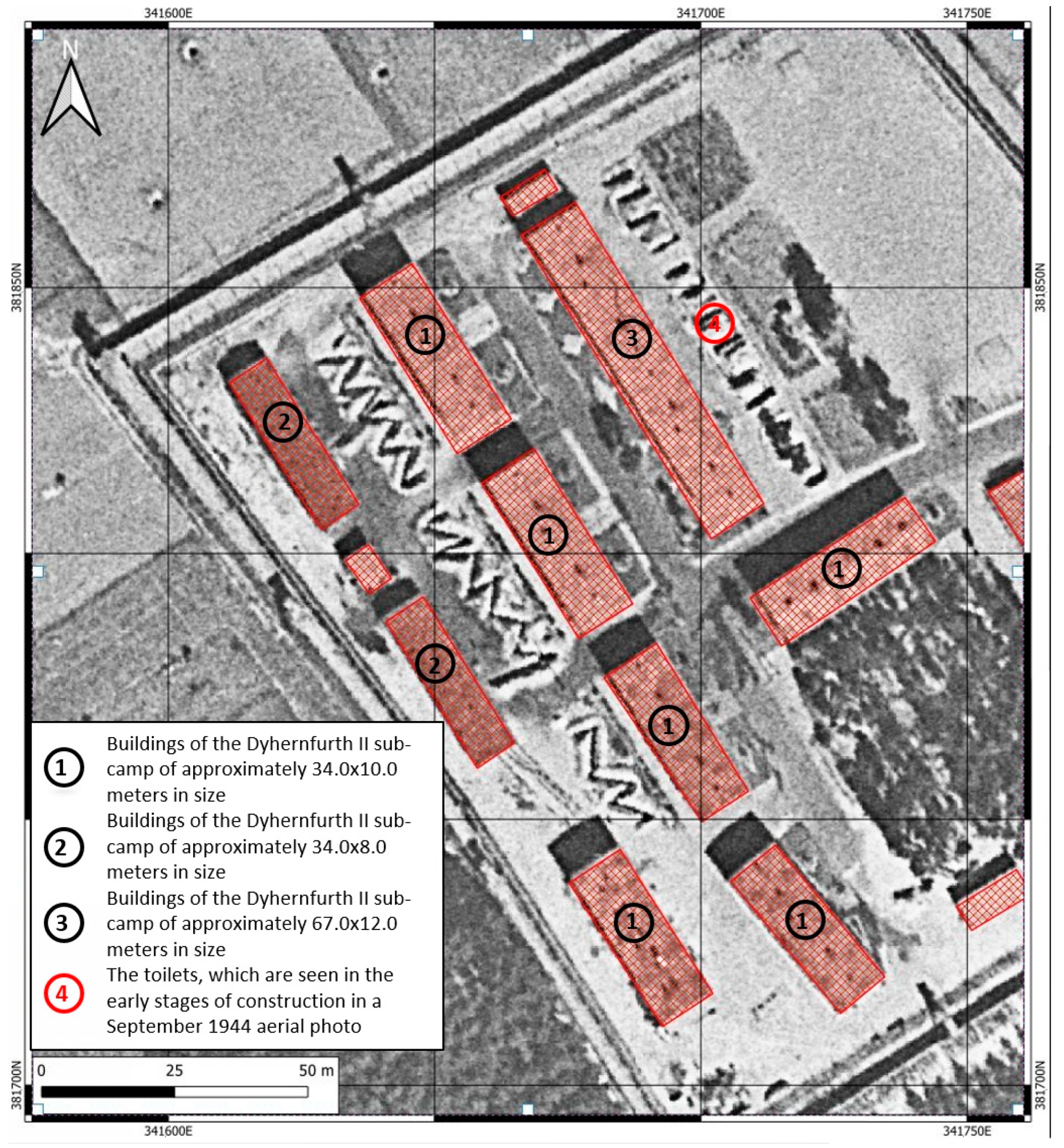

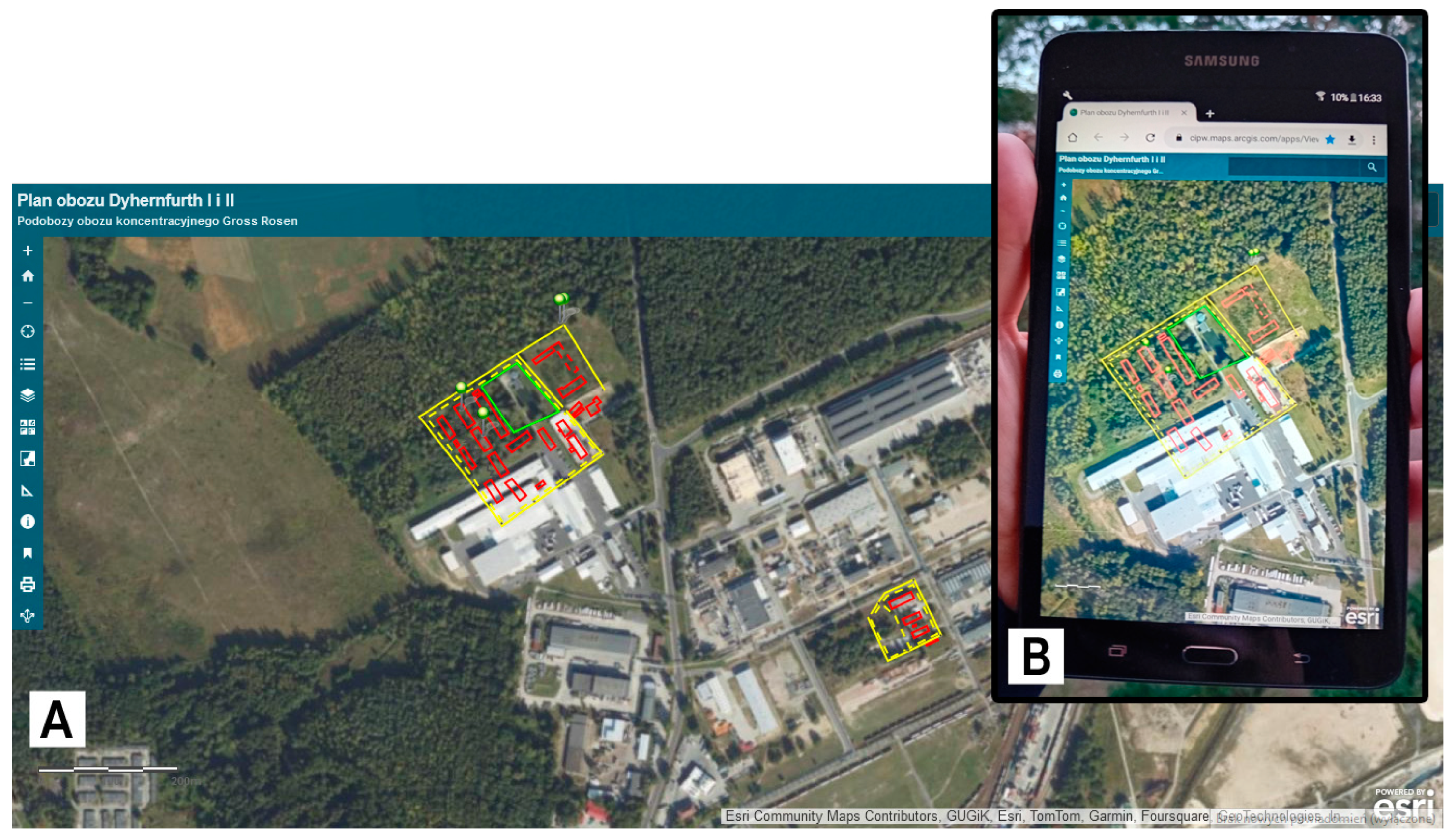
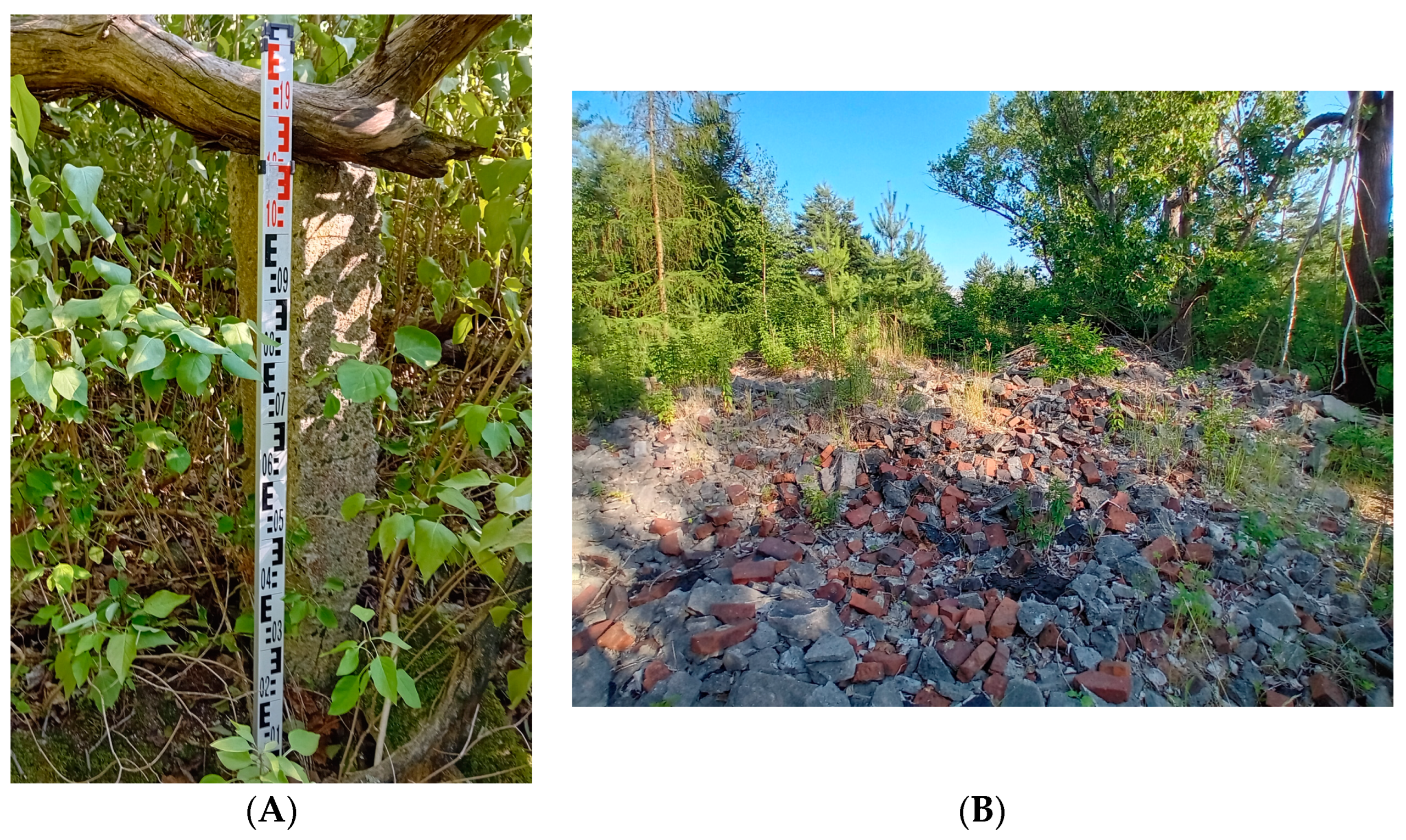
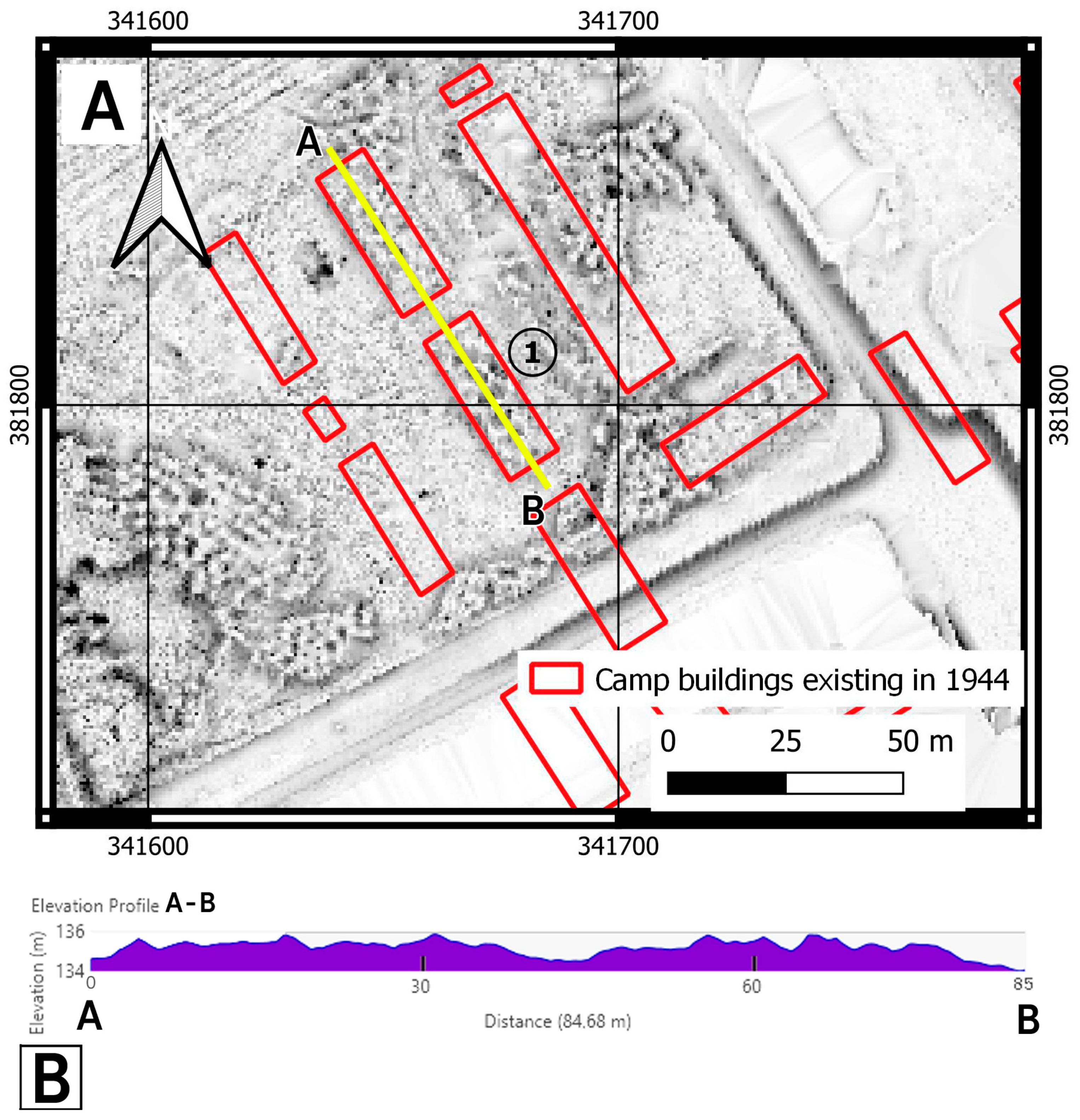
| No. | The Date the Photograph Was Taken | Picture/Ortho Type | Technical Specifications |
|---|---|---|---|
| 1 | 1 November 2021 | RGB, CIR | Format: GeoTIFF |
| GSD: 25 cm | |||
| 2 | 2009 | RGB | Format: GeoTIFF |
| GSD: 50 cm | |||
| 3 | 2004 | Panchromatic | Format: GeoTIFF |
| GSD: 50 cm | |||
| 4 | 16 September 1974 | Panchromatic | Scale 1:25,000 |
Disclaimer/Publisher’s Note: The statements, opinions and data contained in all publications are solely those of the individual author(s) and contributor(s) and not of MDPI and/or the editor(s). MDPI and/or the editor(s) disclaim responsibility for any injury to people or property resulting from any ideas, methods, instructions or products referred to in the content. |
© 2024 by the authors. Licensee MDPI, Basel, Switzerland. This article is an open access article distributed under the terms and conditions of the Creative Commons Attribution (CC BY) license (https://creativecommons.org/licenses/by/4.0/).
Share and Cite
Różycki, S.; Michalski, M.; Kobielec, A. Use of Geoinformatics for the Digitization and Visualization of Sensitive Space in the Urban Landscape: A Case Study of the Gross-Rosen Sub-Camps Systems. Remote Sens. 2024, 16, 783. https://doi.org/10.3390/rs16050783
Różycki S, Michalski M, Kobielec A. Use of Geoinformatics for the Digitization and Visualization of Sensitive Space in the Urban Landscape: A Case Study of the Gross-Rosen Sub-Camps Systems. Remote Sensing. 2024; 16(5):783. https://doi.org/10.3390/rs16050783
Chicago/Turabian StyleRóżycki, Sebastian, Marek Michalski, and Aleksandra Kobielec. 2024. "Use of Geoinformatics for the Digitization and Visualization of Sensitive Space in the Urban Landscape: A Case Study of the Gross-Rosen Sub-Camps Systems" Remote Sensing 16, no. 5: 783. https://doi.org/10.3390/rs16050783
APA StyleRóżycki, S., Michalski, M., & Kobielec, A. (2024). Use of Geoinformatics for the Digitization and Visualization of Sensitive Space in the Urban Landscape: A Case Study of the Gross-Rosen Sub-Camps Systems. Remote Sensing, 16(5), 783. https://doi.org/10.3390/rs16050783







